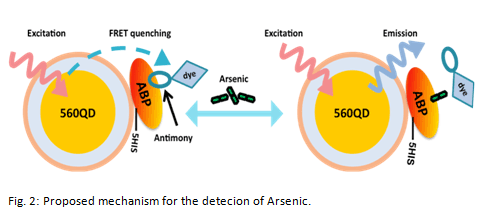Arsenic poisoning of drinking water is a matter of great concern all over the world. The problem is more acute in regions of Bangladesh and in the state of West Bengal in India where many deaths have been reported from arsenic poisoning of drinking water. To tackle this problem there is a need to effectively monitor arsenic contamination of drinking water at the sites and also to decontaminate the water from arsenic. There have been reports on the development of effective arsenic removal systems however field kits that can detect small concentrations (parts per billion, ppb) of arsenic in drinking water still remains a technical challenge. In this project our aim is to develop reliable arsenic detecting devices that can be used in the field and will have the ability to detect arsenic in the ppb range. We are working on two types of arsenic sensing devices. In one method we are exploring the suitability of Fluorescence Resonance Energy Transfer (FRET) mechanism to detect arsenic in water. The other method focuses on detecting arsenic in water by using High Electron Mobility Transistor (HEMT). Both of these devices will be portable and can be used in the field for arsenic detection.

